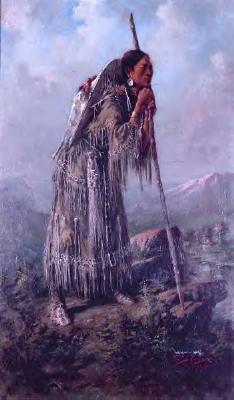|
|
History Before Lewis and Clarke
by Charkoosta News
 BIG SKY
MONTANA-- The 200th anniversary of explorers Lewis and Clark's "Corps of Discovery" trek is nearing,
and tourism-related businesses in the U.S. are gearing up for increased numbers of visitors along the continent-spanning
trail. BIG SKY
MONTANA-- The 200th anniversary of explorers Lewis and Clark's "Corps of Discovery" trek is nearing,
and tourism-related businesses in the U.S. are gearing up for increased numbers of visitors along the continent-spanning
trail.Native American historians are hoping that the Indian point of view won't be ignored this go-round. The impending bicentennial anniversary was discussed at the recent annual Governor's Conference on Tourism here. People's Center director Lucy Vanderburg, representing the Confederated Salish and Kootenai Tribes, told the conference crowd that the explorers "were basically on a business trip" for the fur trade. "In most non-Indian accounts, the arrival of Lewis and Clark marks the beginning of history," she said. "But in reality, they were entering a world older than they could imagine." She said her nation's first encounter with Lewis and Clark remains a part of Salish oral history. Both groups were afraid of each other at first, but soon became friendly, she said. The Salish gave the explorers food and traded fresh horses for the tired mounts of the pale, sickly looking visitors. "They had never seen white people before," she said of the Salish of the early 19th century. "They had short hair. Their faces were pale. They wanted to help these people because they did look pitiful." Similarly, Crow tribal history recalls the Lewis and Clark expedition as "just another bunch of white people going through Crow country," said Mardell Plainfeather, a Crow educator from Hardin. Meriwether Lewis and William Clark trekked through lands that had been settled for thousands of years by Indian tribes, Blackfeet educator Curly Bear Wagner pointed out. "We never cherished them," he said. Much of the later bloodshed between white settlers and soldiers and native tribes could have been avoided, Wagner said, noting that the Blackfeet had been trading with fur companies in Canada for 50 years before Lewis and Clark arrived. "All they had to do was come in and say 'let's trade,"' Wagner said. "But they wanted to come in and take." Still, tribes are looking forward to using the bicentennial of the expedition, will run from 2004 to 2006 and is expected to attract throngs of thousands of tourists, to educate people about their culture and history. Non-Indians can help that effort by inviting tribal members to events and festivals to explain native traditions and perspective to tourists and residents alike, Plainfeather said. The tribes are now working on creation of an intertribal agency that would coordinate requests for Indian speakers and information, Plainfeather said. |
|
|
| Canku Ota is a free Newsletter celebrating Native America, its traditions and accomplishments . We do not provide subscriber or visitor names to anyone. Some articles presented in Canku Ota may contain copyright material. We have received appropriate permissions for republishing any articles. Material appearing here is distributed without profit or monetary gain to those who have expressed an interest. This is in accordance with Title 17 U.S.C. section 107. |
|
Canku Ota is a copyright of Vicki Lockard and Paul Barry. |
|